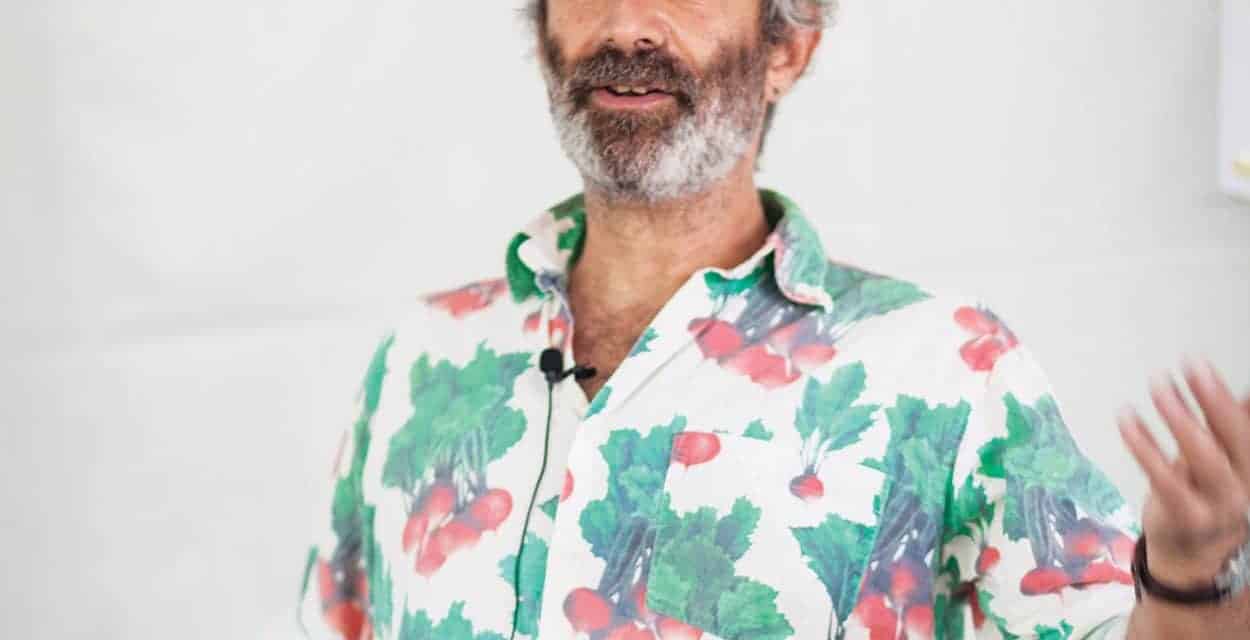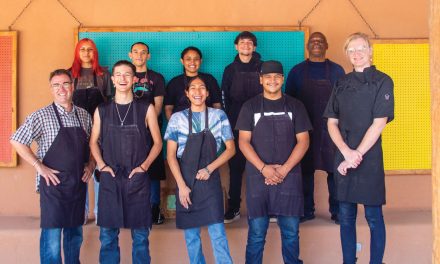Morning with Sandor Ellix Katz
By Katherine Mast · Photos by Gabriella Marks

Fermentation guru Sandor Ellix Katz sporting his radish shirt.
Several dozen early risers pack the seats arranged around folding tables under a large event tent. It’s the second annual New Mexico Fermentation Festival at the Gutiérrez-Hubbell House in Albuquerque’s South Valley. Each table holds an array of produce: corn on the cob, garlic, peppers, leeks, tomatoes, and sweet potatoes. The participants know they’ll be husking and chopping and mixing and, eventually, squeezing, these items together in the morning’s hands-on fermentation workshop. And they know they’ll have to wait a few days—maybe weeks—to taste the fruit of their labor.
It may seem like a strange array of veggies to ferment, says fermentation guru Sandor Ellix Katz, who is standing at the front of the tent, looking relaxed in a radish-print button-up shirt. There’s no sign of the heads of cabbage you might chop for sauerkraut or the cucumbers you’d expect to brine into pickles. It just goes to show, he says, that you can ferment nearly anything.
Katz is one of the most well-known names among modern fermentation enthusiasts. He’s written two books on the subject. The first, Wild Fermentation (Chelsea Green Publishing, 2003) is full of recipes from sauerkrauts and pickles to ginger beer and kombucha. Nearly ten years later, he released The Art of Fermentation (Chelsea Green Publishing, 2012), a compendium of ideas from around the world about the myriad ways to ferment various foods. The 498-page book quickly became a New York Times bestseller and won an award from the James Beard Foundation.
In 1993, Katz packed up his life in Manhattan for a quiet, off-grid move to a commune in Tennessee. There he started keeping a garden. When the first harvest rolled around, he was caught off guard by the amount of produce ripening at the same time. “I was such a naive city kid that I never thought about the idea that, in a garden, all the cabbage would be ready at around the same time,” he says. And so, he decided to learn how to make sauerkraut. “I looked in The Joy of Cooking and there it was: How to make sauerkraut.”
He was hooked. He started fermenting other things: yogurt, sourdough breads, country wines. “I got kind of totally obsessed,” he says. He started branching out, exploring ferments from other cultures, like miso and tempeh.
In the past several decades, fermentation has experienced somewhat of a renaissance in the US. New businesses offering fermented foods, from cured meats and pickles to kombucha and home-fermentation supplies, are popping up each year. Entrepreneurs like Pat Block, who operates Barrio Brinery in Santa Fe, says it took years of work and networking with researchers and regulators in other states before New Mexico was ready to license his fermented pickle business. Block’s work helped open the door for other fermented foods businesses to launch. Now, as Katz shares stories and how-tos with the participants in the tent, rows of local vendors are setting up their own booths.
Katz keeps a regular schedule speaking at such events from Pittsburgh to Portland and from Bogotá to São Paulo. And he travels internationally to learn about the world’s various fermenting traditions. The basics, he tells the participants gathered in the tent, come down to this: “The mechanics of fermenting vegetables is ridiculously simple. You chop vegetables and salt them to taste, squeeze them to break down the cell walls and release juices, then stuff them into vessels, get them submerged under their juices, and let them ferment.”
Scientifically speaking, fermentation is a specific process that produces energy without oxygen, or anaerobically. But when we talk about food, fermentation has a broader definition. Katz defines it as “the transformative action of microorganisms.” Most of the food we call fermented—things like sauerkraut, kimchi, and wine—meet that scientific definition. Submerged in a brine or capped, bacteria and yeast break the ingredients down into delicious complexity. But some do require oxygen—vinegar, kombucha, many cheeses, and tempeh are a few. “I think of these as the oxymoronic ferments,” says Katz.

Katz helps festivalgoers work through their fermentation questions while conducting a live demonstration.
Many of the people at this June Saturday’s demonstration have brought their fermentation questions for the man who has literally written the book(s) on the topic: When do I know my ferment is done? (When it tastes good to you!) What if mold starts growing on the surface of my sauerkraut? (Skim it off!) Can I brew kombucha next to my sauerkraut, or will they contaminate each other? (They’ll be fine! And besides, there’s bacteria and yeast spores floating in the air all the time!)
The growing interest in fermentation is due in part to a growing interest in food more generally, says Katz. As people start asking questions about the environmental and economic impacts of our modern food system, and as more people are favoring locally grown produce, “Fermentation is just part of the answer,” he says.
But fermentation is hardly a novel trend. In fact, it’s one of humanity’s oldest means of preserving food, and is practiced in cultures around the world. “The products of fermentation have enjoyed enduring popularity,” says Katz. “Bread, beer, wine, cheese, coffee, chocolate did not suddenly become popular in the last decade.” While fermented foods have been part of human diets for thousands of years, it was only a few centuries ago that scientists discovered microorganisms like bacteria and yeast, the workhorses that can turn a crock full of cabbage into pungent sauerkraut or cause a loaf of bread to rise.
And for the past hundred and fifty years, we’ve known enough about bacteria to know they can make us sick and that sometimes they can kill us. We’ve been in a hundred-year war on bacteria where we’ve been repeatedly fed information about how to avoid bacteria and been sold products to kill them. But we’re just beginning to understand beneficial microbes, and, specifically, the dynamics within microbial communities. “Until the new millennium, there were no tools for studying bacterial communities. A lot of individual bacteria are studied,” says Katz. “But in the world, bacteria don’t exist in isolation. They exist in these elaborate communities.”
As it turns out, these elaborate bacterial communities are important for our digestion, immune function, and even our mental health. Some scientists describe our gut bacteria—part of our microbiome—as a forgotten organ because of the critical role they play in our health.
There is so much we still don’t know, scientifically, about fermented foods. We really don’t know what happens to the microbes in our food once we eat them—the dynamics between them and the microbes already living in our bodies, or how our bodies regulate these communities.

Fermentation Festival attendees working with their ferments to create a relish with corn, onions, sweet potatoes, and green chiles.
But here are a few things we do know: Fermentation allows microbes to pre-digest some foods we’d have trouble eating otherwise and can make certain minerals easier for our bodies to absorb. Fermentation can remove certain plant toxins, rendering poisonous raw foods, such as bitter cassava, harmless. Fermentation can make raw food safer, creating acidic environments where anaerobic bacteria thrive and pathogens like Salmonella, Listeria, and E. coli will die. (Of course, it’s important to follow safe food-handling guidelines; C. botulinum, which is a serious concern for home-canners and is a potentially deadly botulinum toxin, has shown up in fermented foods, particularly protein-rich ferments of meat, fish, and tofu.) And fermentation can enhance the nutritional value of food, creating micronutrients not found in the raw ingredients.
In Katz’s own experience, and in the anecdotes he receives by the week, fermented foods can profoundly impact our health. But he’s careful not to paint fermented foods as a panacea. In 1991, Katz tested positive for HIV—something he writes and speaks about often—and he says fermented foods have played an important role in maintaining his health. But maintaining health and curing HIV or any other disease are two different things, he says.
“There’s a lot of hype. As someone who’s been living with a chronic disease for decades, I feel like it’s exploitative when people start claiming that a particular food will cure a particular disease,” he says. Fermented foods won’t alone cure AIDS or HIV. They aren’t the cure for cancer. And they won’t reverse aging. “You can eat as much kraut as you want, drink as much kombucha, and it’s not going to make you ten years younger.” But it might make you feel better, and it will probably improve your health, he says.
Back in the tent, as Katz wraps up the first part of his talk, he instructs the participants on how to prepare the relish they’ll be taking home. As he’s done all morning, he intersperses his directions with stories from people he’s met throughout the years, from Korea to North Carolina, and the various ferments they’ve made.
Fermentation seems magical, like making a potion, says one participant who has traveled from Florida to attend the event with her sister. It’s transforming the ordinary into something entirely new. “It’s like being your own kitchen alchemist!” she says.
SAVE THE DATE: The Third Annual Fermentation Festival
will be held on June 23, 2018 at Guttiérez-Hubbell House in
Albuquerque.
Edible celebrates New Mexico's food culture, season by season. We believe that knowing where our food comes from is a powerful thing. With our high-quality, aesthetically pleasing and informative publication, we inspire readers to support and celebrate the growers, producers, chefs, beverage and food artisans, and other food professionals in our community.

















